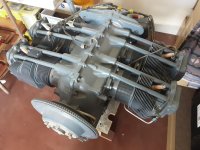PaulvS
Well Known Member
25+ years ago I bought a mid-life O-320-E2C for the RV-6A that I had started building. It has taken much longer than expected but soon it will be time to install the engine and I'm looking for suggestions to help get it prepared for use.
The engine was field overhauled when I got it and upgraded to 160 hp and test run and then the oil was drained. AD's were also completed for new oil pump gears, crank bore seal and a couple of other items. Since then the engine has been stored indoors in my study in a dry climate. During the first few years of storage I sprayed LPS 3 anti-corrosion spray into the cylinders and used dessicant plugs in the top spark plug holes. The dessicant has not been refreshed in a while but I just inspected inside the cylinders with a borescope and there is no sign of any corrosion and the waxy film from LPS 3 is still present. All of the pipe fittings and vents have been capped.
I'm expecting to need to do the following:
- Fit a new or rebuilt MA-4SPA carburetor
- Fit a new mechanical fuel pump
- Get the Bendix magnetos inspected and serviced as required
- Consider fitting a spin-on oil filter to the engine or firewall
- Put oil in the engine and turn it upside down to soak the camshaft before fitting it on the mount
- Wash out the cylinders to remove LPS 3 before first start
Is there anything else that would be important to do?
Thanks!
The engine was field overhauled when I got it and upgraded to 160 hp and test run and then the oil was drained. AD's were also completed for new oil pump gears, crank bore seal and a couple of other items. Since then the engine has been stored indoors in my study in a dry climate. During the first few years of storage I sprayed LPS 3 anti-corrosion spray into the cylinders and used dessicant plugs in the top spark plug holes. The dessicant has not been refreshed in a while but I just inspected inside the cylinders with a borescope and there is no sign of any corrosion and the waxy film from LPS 3 is still present. All of the pipe fittings and vents have been capped.
I'm expecting to need to do the following:
- Fit a new or rebuilt MA-4SPA carburetor
- Fit a new mechanical fuel pump
- Get the Bendix magnetos inspected and serviced as required
- Consider fitting a spin-on oil filter to the engine or firewall
- Put oil in the engine and turn it upside down to soak the camshaft before fitting it on the mount
- Wash out the cylinders to remove LPS 3 before first start
Is there anything else that would be important to do?
Thanks!






